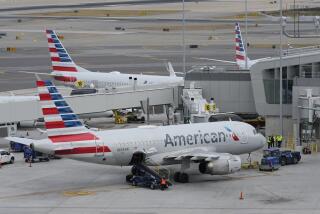In-flight Wi-Fi fees: How to get discounts
I had been reluctant to try in-flight Wi-Fi because of the cost, but when I found a discount that cut the fee to $7.46 on a recent American Airlines flight, I tried the service and liked it. And the connection seemed faster than my DSL at home.
As it turns out, Wi-Fi in the sky doesn’t have to be expensive. And on the ground, many airports offer it for free.
The biggest provider, by far, of onboard Wi-Fi in the U.S. is Gogo Inflight Internet, a division of Aircell in Itasca, Ill., whose system operates on thousands of flights each day in the continental U.S.
Gogo is offered throughout AirTran and Virgin America and on some flights by Air Canada, Alaska, American, Delta, US Airways and United, with plans to expand to more flights and carriers by the end of the year, said Arianne Venuso, company spokeswoman.
Gogo Wi-Fi generally costs $4.95 to $12.95 a flight, depending on the length of the flight and how customers connect — with a smart phone or other mobile device or a laptop.
Here are five ways to get discounts on Gogo Wi-Fi:
1. Take a chance: Once onboard, launch the Gogo home page and see whether it’s offering a deal. That’s how I found my discount on American. It costs nothing to land on Gogo’s home page, and if you don’t like the price, you can exit.
2. Buy before you fly: At GogoInflight.com, recent specials have included a pass good for Wi-Fi on multiple flights in a 24-hour period for $11 (the regular price is $12.95); and six individual passes, each redeemable for Wi-Fi on one flight, for a total of $49.95.
3. Be social: Gogo offers promotions to its followers through the networking websites Twitter and Facebook.
4. Grab coupons: Look for Gogo coupon codes on discount websites such as RetailMeNot.com and Promotionalcodes.com.
5. Log on to partners: Gogo partners, such as Gadling.com, CheapOAir.com and Boarding Area.com, sometimes provide special offers or complimentary passes or codes.
Other providers of in-flight Wi-Fi include Row 44, used by Southwest, and LiveTV’s Kiteline on JetBlue. Row 44 uses satellite technology; both Gogo and Kiteline use air-to-ground technology similar to cellphones.
So far, Southwest has installed Row 44 on only one jet, but it plans to add it to the entire fleet by the end of 2012, said airline spokesperson Whitney Eichinger. The test price is $5 a flight.
At JetBlue, Kiteline, a product that is unique to that airline, is installed on one test aircraft, called BetaBlue. It provides free e-mail and instant messaging, but unlike Gogo and Row 44, it doesn’t offer Web browsing.
Pricing definitely affects usage, Row 44 President Gregg Fialcowitz said.
“When service is free, typically half the passengers will log on,” he said. “The moment you charge anything for the service, the percentage of people using Internet service drops notably. Airlines have to get the price point low enough where value exceeds what the price is.”
At airports, you’ll typically find free Wi-Fi inside airline lounges, such as American’s Admirals Club and Delta’s Sky Club. Such clubs are generally open to first- and business-class passengers and high-mileage frequent fliers; others can often buy a day pass.
At many U.S. airports, any passenger can log on for free in the terminals.
California’s free Wi-Fi airports include Arcata/Eureka, Fresno Yosemite International, Long Beach, Oakland, John Wayne ( Orange County), Sacramento, San Diego International, San Jose International, San Luis Obispo County, Santa Barbara, Santa Maria, Sonoma County, Charles M. Schulz ( Sonoma County) and Santa Ynez. San Francisco’s airport plans to start free Wi-Fi on Sept. 1, spokesman Mike McCarron said.
At Los Angeles International and Ontario International, passengers looking to log on must either buy a $9.99 portable T-Mobile HotSpot day pass or pay $6 for the first hour and 10 cents a minute thereafter.
travel@latimes.com
More to Read
Sign up for The Wild
We’ll help you find the best places to hike, bike and run, as well as the perfect silent spots for meditation and yoga.
You may occasionally receive promotional content from the Los Angeles Times.






